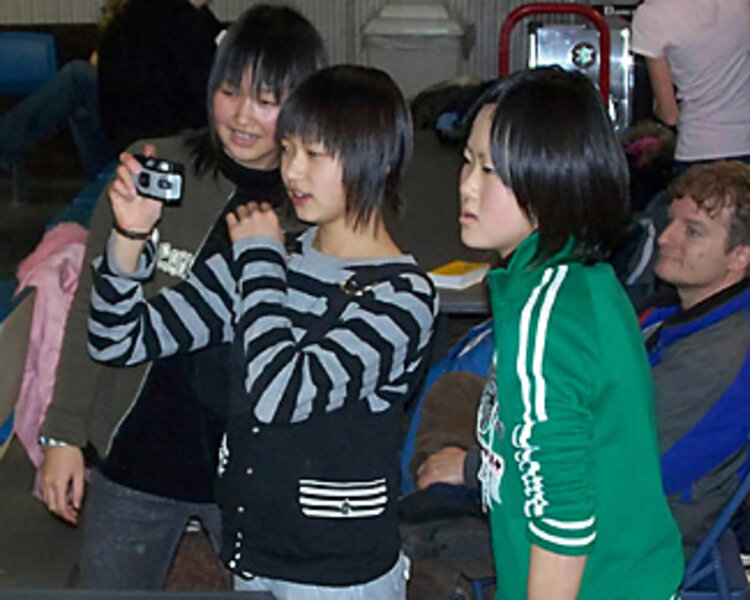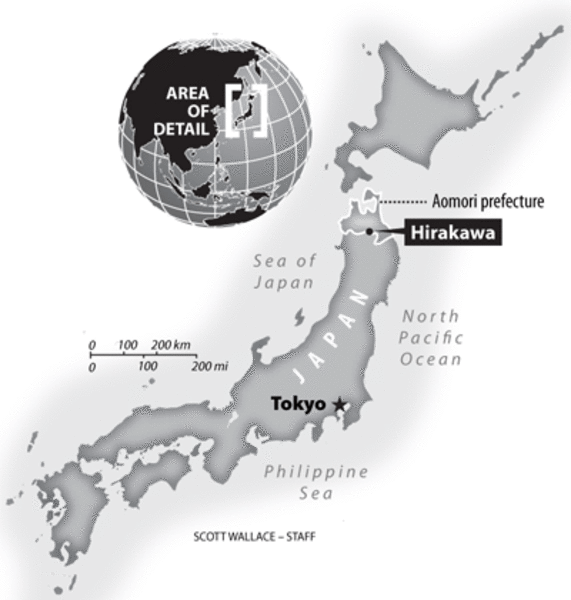Overseas adventure, student-style
Loading...
Three girls – two American and one Japanese – are getting ready to ice skate, but for the moment, their heads are bowed together over small English/Japanese dictionaries. "Suki desu ka?" ("Do you like it?") They point to words, nod their heads, and giggle, then riffle though the pages again so they can communicate: "Do you like cooking?" "Do you like rock music?" Some words become familiar: "motto" (more), "honto?" (really?). They call one another "baka" (silly).
If you've ever wondered what it would be like to host a foreign exchange student or to be one, these girls' experience gives you an idea.
In January 2007, along with nine other Maine families, my family hosted a Japanese exchange student in our home for a week. All were middle-schoolers and their communication skills built steadily from their initial shy moments to late-night fits of laughter.
"Awkward – but fun!" my 13-year-old daughter, Molly, reported the first night. She and her new Japanese friend, Mami Seito, quickly learned that dry-erase boards and pictures eased the language difficulties.
Later, sports and video games offered common ground because bowling, tennis, and games such as "Dance, Dance Revolution" flow wordlessly with universal signals or exclamations.
The Japanese students had studied English for a year or two, but the Americans hadn't been taught Japanese at all. Yet friendships flourished.
Across the sea
It's not just the Japanese students who traveled to a foreign land, though. Students from Camden and Rockport, Maine, went to Japan a few months later to see what life is like there. This tradition began in 1997. That year, the Camden-Rockport Middle School paired with schools in Hiraka, Japan. Different groups of American and Japanese students have been traveling between the "sister schools" ever since.
The Japanese students come during their New Year's break, stopping in New York City to see the highlights. The Maine students usually go to Hirakawa (as the Hiraka area is known today) during summer, but not everyone goes overseas. Students apply to become either hosts or travelers; they can't be both. As one parent remarked, "Hosting eases the disappointment of not being chosen to go to Japan but increases the desire to go."
Grown-ups from the schools also get in on the action. Last year, for instance, the principal of Ikarigaseki Junior High School, Toyoaki Hishiya, came to Camden as a chaperone with students from his school, as did Mitsuo Kasai, a school education division director.
They, too, stayed with host families in Camden and used classroom time to exchange information and ideas with Maine educators.
Camden teachers who often travel to Hirakawa are Dee Kopesky, a computer teacher, and Paula Lavoie, who teaches science. Both view the trips as an exciting chance to learn about another culture and different ways of teaching.
The exchange program is a point of pride for kids and adults at schools in both cities. A colorful flag from a Hirakawa school adorns the cafeteria at Camden-Rockport Middle School, and bold Japanese script graces the building's entryway. But the signs of cross-cultural exchange extend beyond the schools' walls.
Since 1994, the whole state of Maine has shared a "sister state" relationship with Aomori Prefecture, where Hirakawa is located. (A Japanese prefecture is similar to a US state.) Aomori is in northeastern Japan, and Maine is in the northeastern United States. Aomori is known for its apples, rice, and squid. Maine harvests apples, potatoes, and lobsters. Both areas feature mountains near the sea and welcome tourists. And both places have exchanged not only students, but also business and cultural knowledge.
A whole new world
For several years, Japanese students recorded their experiences in Camden online. Their observations show how they felt and what they were learning in their new surroundings.
As one student pointed out, American and Japanese schools sometimes have very different ways of doing things:
"Next, we joined a PE [physical education] class. Without even an opening or closing greeting, everyone just moved their bodies freely.... [Then] we did some warm-up exercises and, using a soccer ball, played a one-on-one game similar to Onigokko. To us, it seemed less like a PE class and more like afternoon recess. Another thing that was different from Japan was that girls and boys had class together."
Another Japanese student described tasting lobster for the first time: "When I dipped it in butter, it had a taste like a cross between shrimp and crab. Really good! Maybe you can eat it with soy sauce, too. In Japan, when we eat crab, we eat the brain, too."
Mami, our exchange student last year, learned to break into her boiled lobster with a shell cracker and small metal fork. Meanwhile, she taught us how to handle chopsticks for the bowl of rice we served on the side.
The American students and host families had plenty of new things to learn. One American mom noted of her Japanese guest, "He would say this phrase before eating, 'Itadakimasu,' which roughly translates to 'gift of nature.' What a nice way to express appreciation for the food we eat."
On the other hand, a boy from Maine who visited Japan one summer confided jokingly to his mother, "They're starving me! They gave me squid for breakfast!"
Omiyage (souvenirs or gifts) are customary in Japan, so both American and Japanese students exchanged small tokens from their countries.
The American students learned to present their gifts with two hands because doing so with just one hand would be rude in Japanese society. And they were instructed not to wrap items in white paper, which can signify death in Japan.
Times to remember
Any international travel may have occasional glitches. Ms. Kopesky, the Camden computer teacher, recalls searching through a dumpster late one night at a ski resort after a Japanese student had misplaced a wallet!
When Mr. Hishiya and his students were on their way back to Japan last year, one of their flights was delayed because of mechanical trouble. On top of that, one boy couldn't get to his passport and cash because he couldn't open the lock box where he kept it. Finally, an airport clerk came to the rescue.
But small snags like these don't stop students and families from building happy memories of their exchange experiences.
"One of our greatest joys – in addition to our sweet guest – was the unexpected enthusiasm, concern, and genuine interest exhibited by our other children," said a Maine parent who hosted a student last year. "Even our golden retriever had uncharacteristic good manners."
The need to translate languages diminishes during the week the students are visiting. As they settle into the rhythm of life with American families, mutual understanding grows naturally, and communication becomes more about feelings than words.
As a Japanese student from the first exchange program in 1997 wrote online: "Because they treated me with kindness even when I was struggling with conversation, I could overcome the difference in language and the differences in custom and communicate using my heart."
Almost everyone emerges from the cross-cultural encounter with an expanded capacity to embrace new neighbors from around the world.
Yokoso! Welcome!






